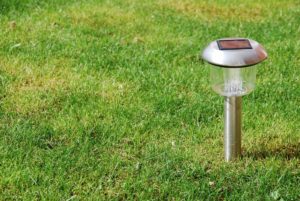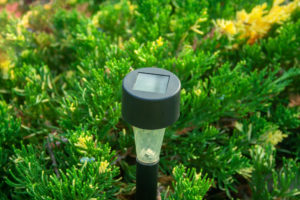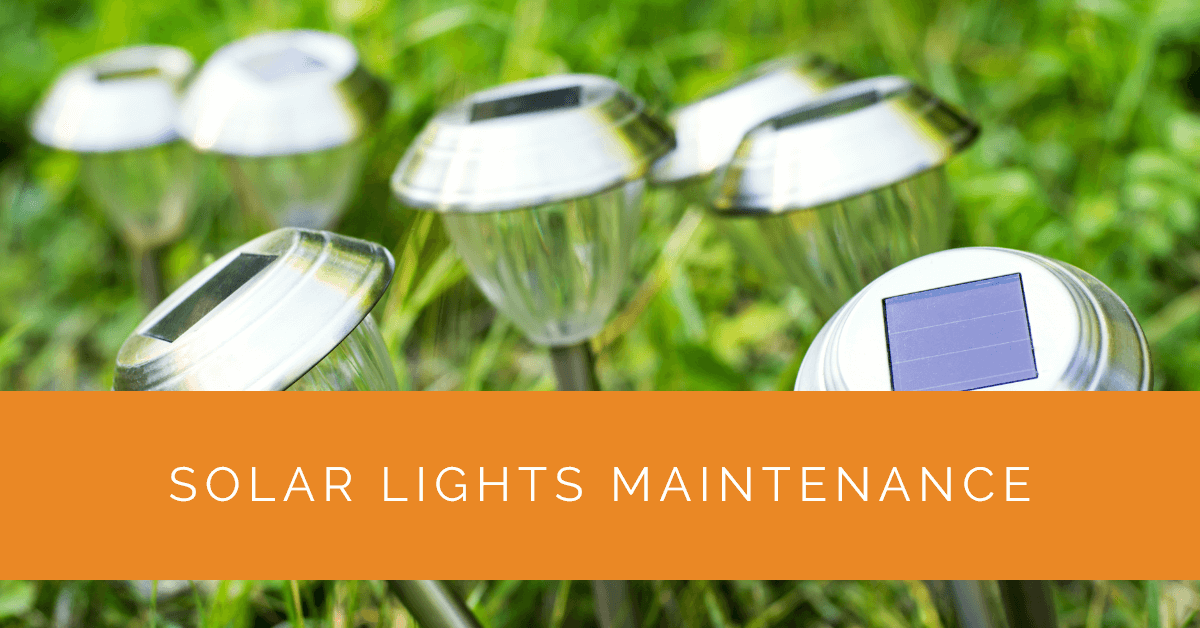Solar-powered lights have revolutionized outdoor lighting, offering energy-efficient and environmentally-friendly illumination. However, proper maintenance is crucial to ensure they work optimally and have a long lifespan. This guide delves into essential tips and techniques for maintaining solar lights and fixtures.
Contents
- 1 Key Takeaways
- 2 Understanding Solar Lights and Fixtures
- 3 Cleaning the Solar Panels
- 4 Checking the Batteries
- 5 Dealing with Corrosion
- 6 Replacing the Batteries
- 7 Signs Your Lights Need Maintenance
- 8 Addressing Light Blockage from Nearby Shrubs and Trees
- 9 Regular Maintenance Tips
- 10 Case Study: Ensuring Optimal Performance of Outdoor Solar Lights
- 11 Expert Insights From Our Solar Panel Installers About Solar Lights Maintenance
- 12 Our Expertise in Solar Lights
- 13 Conclusion
Key Takeaways
- Regular maintenance keeps outdoor solar panel lights shining bright and efficiently.
- Cleaning the solar panels, checking and replacing batteries, and addressing corrosion are essential maintenance tasks.
- Properly maintaining solar lights ensures optimal performance longer lifespan, and contributes to a greener environment.
Understanding Solar Lights and Fixtures
How Solar Lights Work
Outdoor solar lights are powered by photovoltaic cells that convert sunlight into electricity. This energy is stored in rechargeable batteries to illuminate the LED lamps when it gets dark. The automatic on/off mechanism makes them energy-efficient and hassle-free.
Types of Solar Light Fixtures
Solar lights come in various styles, including pathways, gardens, floodlights, and wall-mounted fixtures. Each type has specific installation and maintenance requirements, so understanding the variety available can help you choose the best ones for your outdoor space.
Cleaning the Solar Panels
Why Clean Solar Panels Matter
Solar panels are the heart of solar lights, absorbing sunlight to generate electricity. Dust, dirt, and other debris can obstruct the panels, reducing their efficiency and affecting the light output. Regular cleaning is essential to maintain optimal performance.
Step-by-Step Guide to Clean the Solar Panels
- Removing Dust and Debris: Switch off the solar lights and let them cool down before cleaning. Use a soft brush or cloth to gently remove any loose dirt and debris from the surface of the solar panels.
- Washing with Mild Soap Solution: Prepare a solution of warm water and mild soap. Dip a sponge or cloth into the soapy water and gently scrub the solar panels. Avoid using harsh chemicals, as they may damage the panels.
- Rinsing with Water: After scrubbing, rinse the solar panels thoroughly with clean water to remove any soap residue.
- Drying the Panels: Allow the solar panels to air dry or use a soft cloth to wipe away excess water. Ensure the panels are completely dry before turning the lights back on.

Checking the Batteries
The Role of Batteries in Solar Lights
Rechargeable batteries store the solar energy collected during the day, providing power for the LED lamps at night. Checking the batteries regularly ensures they are in good condition and can hold an adequate charge.
Signs that Batteries Need Attention
- Dim or Flickering Lights: If your solar lights are not providing sufficient illumination or flickering, it could indicate battery issues.
- Inconsistent Charging: If the lights do not stay on for the expected duration, the batteries might not be charging properly.
- Cloudy Panels: Dirty or cloudy solar panels can reduce the charging efficiency of the batteries.
How to Check Battery Health
- Voltage Test: Use a multimeter to measure the voltage of the batteries. A fully charged battery should have a voltage close to its rated capacity. If the voltage is significantly lower, it’s time to consider replacement.
- Capacity Test: To determine the battery’s capacity, charge it fully and then discharge it while measuring the time it takes for the light to go out. Compare this time with the manufacturer’s specified capacity to assess battery health.
Dealing with Corrosion
Identifying Corrosion in Solar Lights
Corrosion can occur on the battery terminals, solar panel connectors, or other metal parts due to exposure to moisture and environmental factors. It can hinder the proper functioning of solar lights and should be addressed promptly.
Preventing Corrosion
- Ensure all connections are secure and insulated to prevent moisture ingress.
- Apply a layer of silicone grease on connectors and battery terminals to protect against corrosion.
Cleaning Corroded Parts
- Disconnect the Solar Light: Before cleaning, disconnect the solar light from its power source to ensure safety.
- Gently Remove Corrosion: Use a small brush or sandpaper to remove corrosion from the affected areas gently. Be careful not to damage any electrical components.
- Apply Vinegar Solution: Mix equal parts of white vinegar and water. Add a cotton swab or cloth in the solution to the corroded parts. Vinegar helps dissolve corrosion and clean metal surfaces.
- Dry and Reconnect: Thoroughly dry the parts and reconnect the solar light after cleaning. Check if it functions properly.
Applying Protective Coating
To provide an extra layer of protection against corrosion, consider applying a thin coat of anti-corrosion spray or paint on metal parts.

Replacing the Batteries
When to Replace Solar Light Batteries
Over time, rechargeable batteries in solar lights may lose their ability to hold a charge effectively. If regular maintenance and cleaning do not improve performance, replacing the batteries is time.
Steps to Replace Batteries
- Check Compatibility: Purchase batteries that are compatible with your solar light model. Refer to the user manual or the manufacturer’s website for specifications.
- Open the Solar Light: Depending on the model, you may need to remove screws or open a panel to access the batteries.
- Replace Old Batteries: Carefully remove the old batteries and replace them with new ones. Ensure proper polarity alignment.
- Close and Test: Close the solar light securely and allow it to charge fully in direct sunlight before testing its illumination at night.
Signs Your Lights Need Maintenance
- Flickering or Dim Lights: If your solar lights are flickering or providing dim illumination, it could be a sign of dirty solar panels, worn-out batteries, or other maintenance issues.
- Inconsistent Charging: If your solar lights don’t stay illuminated for the expected duration, it indicates charging or battery problems.
- Discolored or Foggy Panels: Cloudy or discolored solar panels hinder the absorption of sunlight, affecting overall performance.
Addressing Light Blockage from Nearby Shrubs and Trees
The positioning of your solar lights is essential for efficient charging. Nearby shrubs and trees can cast shadows, reducing the amount of sunlight reaching the solar panels. Trimming vegetation regularly can prevent such light blockage.
Regular Maintenance Tips
- Establish a Maintenance Schedule: Set a regular schedule for cleaning and inspecting your solar lights. Depending on the environment, a quarterly or biannual checkup may be sufficient.
- Seasonal Maintenance Checklist: Before each season, thoroughly clean the solar panels and check battery health to ensure optimal performance during changing weather conditions.
- Extreme Weather Precautions: During severe weather conditions, such as heavy rain or snow, temporarily store solar lights indoors to protect them from potential damage.
Case Study: Ensuring Optimal Performance of Outdoor Solar Lights
Background
At Solar Panels Network USA, we emphasize the importance of regular maintenance to ensure the longevity and efficiency of solar-powered lights. A residential client in a coastal area experienced issues with their outdoor solar lights, including dim illumination and inconsistent charging. This case study details our approach to diagnosing and addressing these issues to restore the optimal performance of the solar lights.
Project Overview
The client’s property featured various solar light fixtures, including pathway lights, garden lights, and wall-mounted fixtures. Given the coastal environment, the lights were exposed to salt air and moisture, leading to frequent maintenance challenges. Our goal was to identify and resolve the issues affecting the lights’ performance and implement a maintenance plan to prevent future problems.
Implementation
Initial Assessment
We began with a comprehensive assessment of the client’s solar lights, examining the condition of the solar panels, batteries, and fixtures. We identified several key issues:
- Dirty solar panels obstructing sunlight absorption
- Corroded battery terminals and connectors
- Worn-out rechargeable batteries
Cleaning the Solar Panels
Step-by-Step Cleaning Process:
- Removing Dust and Debris: We switched off the solar lights and allowed them to cool down. Using a soft brush, we gently removed loose dirt and debris from the surface of the solar panels.
- Washing with Mild Soap Solution: We prepared a solution of warm water and mild soap, using a sponge to gently scrub the solar panels without damaging them.
- Rinsing with Water: After scrubbing, we thoroughly rinsed the panels with clean water to remove any soap residue.
- Drying the Panels: We allowed the panels to air dry and used a soft cloth to remove any excess water.
Checking and Replacing Batteries
Battery Health Check:
- Voltage Test: Using a multimeter, we measured the voltage of the batteries. Many were significantly below their rated capacity, indicating the need for replacement.
- Capacity Test: We charged the batteries fully and measured their discharge time. Most batteries failed to hold a sufficient charge, confirming the need for new batteries.
Battery Replacement Steps:
- Checking Compatibility: We sourced batteries compatible with the client’s solar lights, referring to the user manuals for specifications.
- Replacing Old Batteries: We carefully removed the old batteries and replaced them with new ones, ensuring correct polarity alignment.
- Testing Illumination: After replacing the batteries, we allowed the lights to charge in direct sunlight and tested their illumination at night to ensure proper functioning.
Addressing Corrosion
Corrosion Removal Process:
- Disconnecting the Solar Lights: For safety, we disconnected the lights from their power source before cleaning.
- Gently Removing Corrosion: Using a small brush and sandpaper, we carefully removed corrosion from the affected areas.
- Applying Vinegar Solution: We used a mixture of white vinegar and water to clean the corroded parts, which helped dissolve the corrosion.
- Drying and Reconnecting: After cleaning, we thoroughly dried the parts and reconnected the solar lights, ensuring they functioned properly.
Preventive Measures:
- Applied a thin coat of anti-corrosion spray on metal parts
- Ensured all connections were secure and insulated to prevent future moisture ingress
Results
Following these maintenance steps, the client’s solar lights regained their optimal performance. The lights provided consistent and bright illumination, and the maintenance plan we implemented ensured their longevity despite the challenging coastal environment.
Summary
This case study demonstrates the importance of regular maintenance for outdoor solar lights. By cleaning the solar panels, checking and replacing batteries, and addressing corrosion, Solar Panels Network USA helped restore the client’s solar lights to peak performance. Regular maintenance not only enhances the functionality and lifespan of solar lights but also contributes to a greener and more sustainable environment. Our expertise ensures that clients can enjoy the benefits of eco-friendly and cost-effective outdoor lighting for years to come.
Expert Insights From Our Solar Panel Installers About Solar Lights Maintenance
Regular maintenance is crucial for solar lights. Cleaning the solar panels regularly ensures they can absorb sunlight efficiently, which directly impacts their performance and longevity.
Senior Solar Technician
Checking the batteries periodically is essential. If your lights are dim or flickering, it might be time to test and replace the batteries to maintain optimal illumination.
Lead Installation Specialist
Addressing corrosion promptly can prevent long-term damage. Applying a protective coating and keeping connections secure can significantly extend the lifespan of your solar lights.
Solar Maintenance Expert
Our Expertise in Solar Lights
At Solar Panels Network USA, we’re here to provide you with valuable information and support regarding solar lighting. With our experience and understanding of the solar lighting industry, our team of experts is prepared to assist you in finding the right lighting solution for your needs. Whether you’re interested in improving your outdoor spaces, conserving energy, or adopting a more sustainable approach, we’re well-equipped to help. Please feel free to contact us with any questions or inquiries.
Conclusion
Proper maintenance is the key to keeping your outdoor solar panel lights shining bright and illuminating your spaces beautifully. By following the maintenance tips outlined in this guide, you can extend the lifespan of your solar lights, improve their performance, and contribute to a greener and more sustainable environment.
Remember, regular cleaning, battery checks, and addressing corrosion ensure that your solar lights remain efficient and reliable illumination sources, enhancing the charm and safety of your outdoor areas. So, start maintaining your solar lights today and enjoy the benefits of eco-friendly, cost-effective, and brilliant outdoor lighting for years.
About the Author
Solar Panels Network USA stands at the forefront of solar energy solutions, driven by a team of seasoned solar engineers and energy consultants. With over decades of experience in delivering high-quality solar installations and maintenance, we are committed to promoting sustainable energy through customer-centric, tailored solutions. Our articles reflect this commitment, crafted collaboratively by experts to provide accurate, up-to-date insights into solar technology, ensuring our readers are well-informed and empowered in their solar energy decisions.

